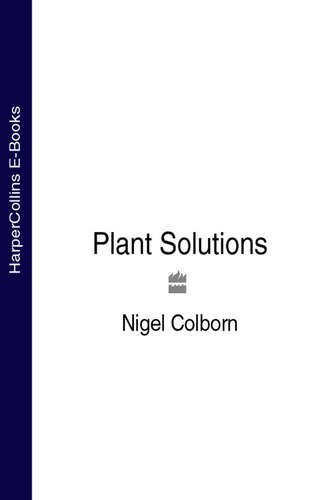
Полная версия
Plant Solutions
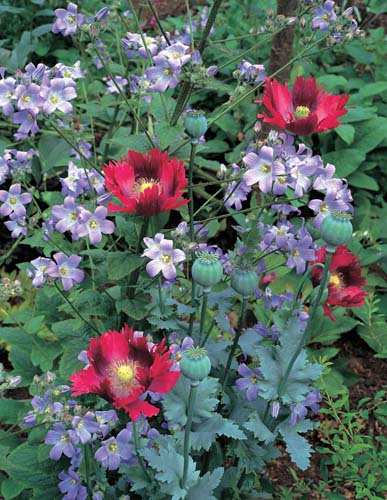
An informal grouping of Campanula lactiflora with a red flowered opium poppy.
Planting Schemes Using Annuals
The main point about annuals – and therein lies their charm – is that they are shortlived. Even the most stalwart, enduring individuals are done after a few months; few last for more than half a summer and many flower and die within a few weeks. Effective planting, therefore, depends on rotation, careful timing, large numbers and bold placing.
Many annuals are also somewhat unpredictable, growing larger and brighter than expected in favourable years, but failing to achieve their potential in difficult seasons. Since they seed copiously and since many adopt the role of biennials and will survive a winter, having germinated in the autumn, their short lives are often compensated for by rapid reproduction and a sustained succession. With the hardiest, such as Nigella, Calendula or Papaver, flowering can sometimes come in waves, with early and copious summer flushes from seed sown the previous autumn, a further wave from spring-germinated seed and a finale from summer-sown seed. Flowering times can also be brought forward by artificial sowing, pre-season, in trays or cells and planting out the young plants. Tender annuals will not sustain their colonies outdoors, where winter frost is expected, but hardy species can be left to their own devices and should ensure colour through much of the growing season.
Annuals as blenders
Although they work very well in their own company, the most common use of annuals is as gap fillers, or to accompany other, more permanent plants in mixed schemes. The main picture shows an informal grouping of Campanula lactiflora (bellflower) with red-flowered opium poppies. The foliage of both plants contrast well, the pale, glaucous leaves of the poppy having a markedly different colour, texture and shape from the smaller, rougher leaves of the bellflower. As they bloom, the large poppies are backed up by the starry, curled petals of the bells in their pastel lavender tones.
The photograph represents a tiny moment, probably no more than a 60th of a second! The plant association needs to last for several weeks at least and preferably for months, and yet each poppy blooms for no more than a day. The display, however, is far less ephemeral than it looks. After flowering, the campanula would be cut hard back to promote a second flush of flowers. As the opium poppy loses the last of its petals, the shapely seed capsules, held on stiffening stems, will continue to provide an architectural outline. By the time the bellflower has re-grown and is blooming again, the spent poppy will shift in colour from glaucous green to beige, and hence will continue to provide a contrast.
Caution is needed with the poppy, as with many annuals, to prevent unnecessary spread of seed by destroying seedlings while still young. Poppies, among all annuals, are probably the most fecund, and their seeds have a staggeringly long period of viability, countable in decades rather than years!
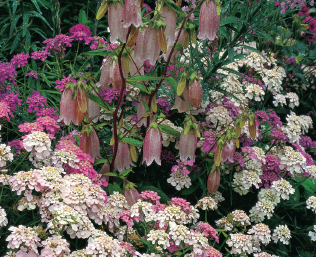
This group is spectacular for the present, but less successful as a lasting association. The candytuft (Iberis) makes a strong companion to the Korean perennial Campanula takesimana, picking up some of its tones but with cleaner, brighter colours and making a bright carpet. However, although it is slightly longer in flower than the poppy, it lacks an attractive aftermath and has undistinguished foliage.
Annuals for attracting beneficial insects
Clarkia pulchella
Hardy annual
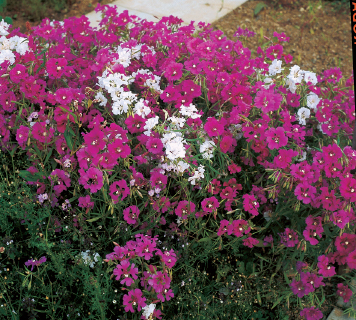
A pretty annual from the Rocky Mountains with thin stems furnished with attractively ruched, funnel-shaped flowers in soft hues of pink, mauve or rosy purple. Gardenworthy seed series include ‘Choice Double Mixed’ and ‘Apple Blossom’, whose flowers, being apricot with white touches, could hardly look less like apple blossom!
Soil preference: Any free-draining, reasonably fertile
Aspect: Sun
Season of interest: Summer
Height and spread: 45cm × 30cm (18in × 12in)
Companion plants: Plants with an understated beauty, best placed with other pastel, crimson or purple annuals. Or use as gap fillers in a mixed or perennial border.
Euphorbia lathyrus
Caper Spurge Hardy annual
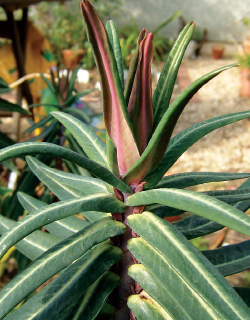
A member of the spurge family which produces an erect, single stem with leaves held opposite one another in pairs, forming an unusual cross pattern. The green flowers, despite resembling capers, are highly poisonous and attract many species of fly which, in turn, attract predators. If wounded, all parts of the plant exude a milky, irritant sap.
Soil preference: Any
Aspect: Any
Season of interest: Spring, summer
Height and spread: Up to 1.5m × 25cm (5ft × 10in)
Companion plants: Not a great beauty but effective as a foil for more colourful plants. Its erect stance makes a pleasing contrast with more pendulous shapes including arching grasses and phormiums.
Linaria maroccana
Morocco Toadflax Hardy annual
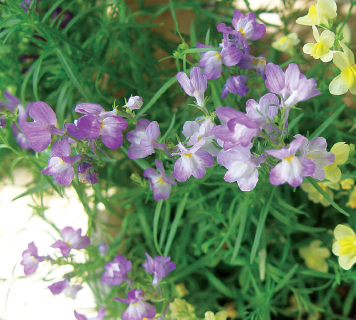
A pretty annual whose branching stems are furnished with simple, narrow leaves, which terminate with long-lasting spikes of small, spurred ‘snapdragon’ flowers. Colours are very variable in the wild species, with pink, yellow, dusky red, white or purple, each bloom usually having a deep yellow pollen guide. Garden varieties include ‘Fairy Bouquet’ in mixed colours, ‘Fantasy blue’ and ‘Northern Lights’, which has fragrant blooms.
Soil preference: Any free-draining
Aspect: Sun
Season of interest: Summer
Height and spread: 20cm × 30cm (8in × 1ft)
Companion plants: A pretty annual to seed in a gravel garden, among low-growing grasses or to follow on from helianthemums and dwarf bearded irises.
Iberis umbellata
Candytuft Hardy annual
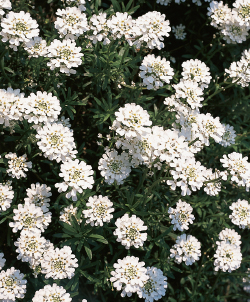
Often a child gardener’s first success, candytuft is an easily grown, quick-acting plant with simple leaves and branched stems which bear umbels of four-petalled, lilac, pink or white flowers. The outer petals on each umbel are larger than the inner, creating a lace-cap effect. Self sows freely in friable soil. Attractive to bees and butterflies.
Soil preference: Any
Aspect: Sun or part shade
Season of interest: Spring, summer
Height and spread: Up to 30cm × 15cm (12in × 6in)
Companion plants: Useful gap filler among the leaves of perennials which will flower later or naturalized in cottage style plantings with pinks, sweet Williams or other annuals.
Limnanthes douglasii
Poached Egg Plant Hardy annual
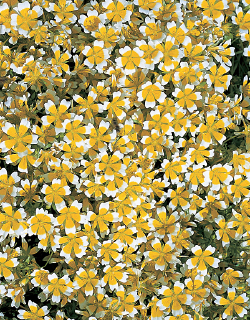
A remarkably versatile, wildlife-friendly, low energy plant. Produces a moisture-retaining dense carpet of vivid green vegetation and when the bright yellow and white flowers open, in late spring and early summer, they are irresistible to bees. Though annual, self-seeding will usually allow these plants to develop self-sustaining colonies.
Soil preference: Any, not too dry
Aspect: Sun or part shade
Season of interest: Spring, summer
Height and spread: 15cm × 20cm (6in × 8in)
Companion plants: Useful to plant in front of shrubs, where they will make a bright carpet, or to scatter along the front of an annual border. Limnanthes also looks handsome grown among tuft-forming grasses such as Festuca glauca.
Calendula officinalis
Marigold, Pot Marigold Hardy annual
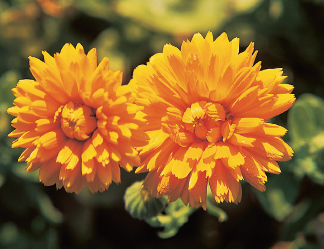
Familiar, aromatic annual with big daisy flowers, single or double, in the yellow and orange colour range. Modern series include the dwarf ‘Citrus Cocktail’ and taller ‘Touch of Red’, whose petals have dark edges. ‘Art Shades’ are tall, traditional marigolds with orange to yellow, fully double flowers. Prone to mildew in damp years.
Soil preference: Any free-draining and fertile
Aspect: Sun, partial shade
Season of interest: Summer, autumn
Height and spread: From 15–60cm × 45cm (6–24in × 18in)
Companion plants: The hot colours are excellent to contrast with blue larkspur and annual Convolvulus or to pep up a cottage border. Also good for creating a wild meadow effect with other hardy annuals and cornfield blooms.
Annuals for scent
Reseda odorata
Mignonette, Bastard Rocket Hardy annual
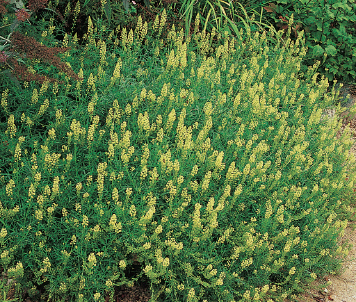
R. Coates
An unassuming little plant from Southern Europe, with simple leaves and spikes of tiny greenish flowers, each with a tuft of orange stamens. The plant’s main distinguishing feature is its sweet fragrance, making it perfect to plant near an outdoor seating area. Attractive to moths and other nectar-seeking insects.
Soil preference: Any, fertile, free-draining
Aspect: Sun, part shade
Season of interest: Summer
Height and spread: 45cm × 20cm (1ft 6in × 8in)
Companion plants: Pretty among such annuals as calendulas and Nigella or perhaps in a fragrant border with roses, pinks and nicotianas.
Nemesia cheiranthus ‘Masquerade’
Half hardy annual
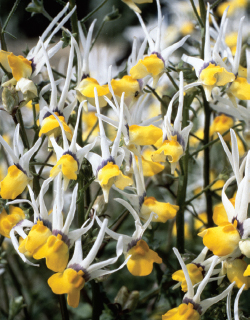
An odd-looking relative of the more familiar bedding plant whose branching stems bear bicoloured flowers with elongated, narrow upper petals in white, contrasting with broad, two lobed lower petals which are yellowish orange. The plant has a the rich fragrance of roasted or candied coconut.
Soil preference: Fertile but free-draining
Aspect: Sun
Season of interest: Summer
Height and spread: 30cm × 20cm (12in × 8in)
Companion plants: An interesting plant for a hanging basket, perhaps planted with golden flowered Bidens ferulifolia or with Lamium ‘Golden Anniversary’.
Tagetes lucida
Mexican Mint or Spanish Tarragon Perennial, usually grown as an annual
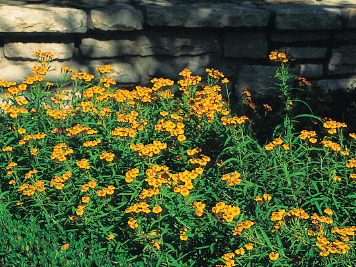
Differing from better known members of the genus by having simple, rather than filigree, leaves, this plant has culinary value as well as beauty. The leaves and branched stems are highly aromatic – reminiscent of aniseed. It has bright golden flowers whose outer ray florets are broad, surrounding a raised central tuft of fertile florets.
Soil preference: Free-draining but fertile
Aspect: Sun
Season of interest: Summer
Height and spread: 60cm × 40cm (2ft × 1ft 8in)
Companion plants: One for the herb garden, perhaps planted with marjoram, basil and summer savory.
Scabiosa atropurpurea ‘Dwarf Double’
Hardy annual
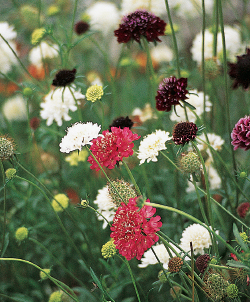
A shorter, more compact form of the familiar Southern European plant described here. The blooms are as large as those on taller varieties and come in a rich colour range, which includes blue, mauve, cream, pink and white. The flowers, which are excellent for cutting, have a gentle fragrance.
Soil preference: Rich, fertile but free-draining
Aspect: Sun or part shade
Season of interest: Summer
Height and spread: 45cm × 30cm (1ft 6in × 1ft)
Companion plants: A fine selection for mixed flower borders or simply to line out for cutting. Also effective with annual grasses, hardy geraniums and other meadow flowers.
Matthiola longipetala subsp. bicornis
Night Scented Stock Hardy annual

R. Coates
An intensely fragrant annual from Southern Europe which looks far more spectacular when illustrated in seedsmen’s catalogues than when seen growing in a garden. The thin, frail stems bear small, irregularly shaped, pinkish-mauve four-petalled flowers. Improved series such as ‘Scentsation’ have white, deeper purple and pale pink among their colours.
Soil preference: Any
Aspect: Sun or part shade
Season of interest: Spring, summer
Height and spread: 30cm × 16cm (12in × 6in)
Companion plants: Frequently mixed with Virginian stocks before sowing or grown in a bed under a window or by a door so that the fragrance can be enjoyed at twilight. A positive cocktail of fragrances can be mixed with mignonette and dwarf sweet peas.
Laurentia axilliaris syn. Isotoma axilliaris or Solenopsis axilliaris
Tender annual
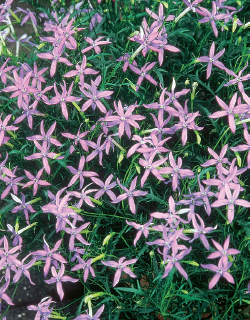
Narrow leaves and trailing stems form a shapely dome on which the star-shaped flowers appear over many weeks and exude a gentle but telling fragrance. Interesting varieties include ‘Stargazer Mixed’, whose colours may be white, blue or pink, and the compact ‘Blue Stars’.
Soil preference: Fertile, free-draining
Aspect: Sun
Season of interest: Summer
Height and spread: 20cm (8in), trailing
Companion plants: Ideal for hanging baskets, especially if planted with Callibrachoa, Scaevola, ivy leaved pelargoniums or trailing petunias.
Annuals for low-allergen gardens
Impatiens glandulifera
Himalayan Balsam, Policeman’s Helmet Hardy annual
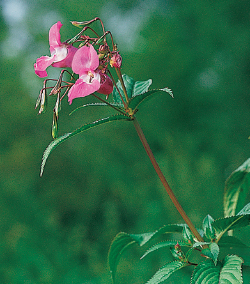
Heather Angel
Tall, fast growing annual with fleshy stems and hairless leaves. From early summer onwards, a succession of large, helmet-shaped flowers precedes the pressure-packed seed capsules which explode, when touched, scattering their seed. An invasive plant that can be damaging in the wild, but an unusual garden annual.
Soil preference: Moist
Aspect: Part shade
Season of interest: Summer
Height and spread: To 1.5m × 45cm (5ft × 1ft 6in)
Companion plants: Best grown as a marginal or bog plant, with such other large species as Ligularia clivorum or Rodgersias.
Nigella papillosa
Hardy annual
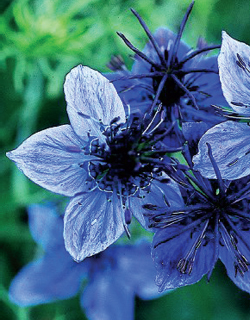
A curious annual with single, five-petalled, dusky blue flowers and very finely divided foliage. The spidery seed heads are as interesting as the flowers, and can also be cut and used dry. Nigella sativa is a similar species, with aromatic seeds which are sometimes used as spices, hence the colloquial name Nutmeg Flower or Roman Coriander.
Soil preference: Any, free-draining
Aspect: Sun
Season of interest: Summer, autumn
Height and spread: 75cm × 30cm (2ft 6in × 1ft)
Companion plants: Useful as a border gap filler, where the seedheads can be left to accompany late summer daisies such as rudbeckias and heleniums or goldenrods.
Scabiosa prolifera
Carmel Daisy Hardy annual
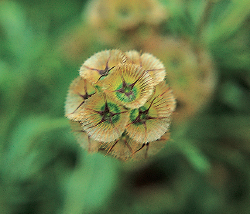
A sun-loving scabious which produces a mass of pale yellow flowers followed by dramatic, rounded seedheads whose sepals form cells rather like those of a honeycomb. Excellent for indoor decoration – fresh or dried.
Soil preference: Any free-draining, reasonably fertile
Aspect: Sun
Season of interest: Summer
Height and spread: 60cm × 20cm (2ft × 8in)
Companion plants: Pretty in an annual border, perhaps with nigellas, which also have pleasing seedheads and with such annual grasses as Lagurus or Briza maxima, whose drying heads are also handsome.
Papaver somniferum
Opium Poppy Hardy annual
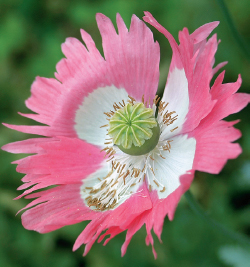
The leaves of opium poppies are bold, ruffled, blue-green and hairless. Many-branched stems produce large conspicuous flowers that are single or double and vary in hue from mauve, purple and pink to crimson or white. Shapely pepperpot seed capsules follow the flowers and persist into autumn. See also pages ref 1 and ref 2 for more poppies.
Soil preference: Free-draining, well worked
Aspect: Sun
Season of interest: Summer, autumn
Height and spread: Variable to 1.5m × 45cm (5ft × 1ft 6in)
Companion plants: Surprisingly pretty among shrub roses, particularly when the leaves contrast, but also popular in cottage schemes with early perennials such as lupins, campanulas or cranesbills.
Lobelia erinus
Lobelia Half hardy perennial usually grown as an annual
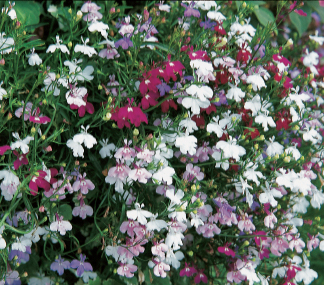
A low allergen bedder with predominantly cool blue or white flowers – although some series come in mauve hues. ‘Cambridge Blue’ is an excellent, compact and long-flowering variety in pale blue. ‘Crystal Palace’ has bronze-tinted foliage and deep blue flowers. The old variety, ‘Mrs Clibran Improved’, is extremely neat with white-eyed blue flowers. (For other lobelias, see pages ref 1 and ref 2.)
Soil preference: Fertile, not too dry
Aspect: Sun or part shade
Season of interest: Summer
Height and spread: Variable to 20cm × 20cm (8in × 8in)
Companion plants: Traditionally used in pots or as border edging but also handsome when used informally amongst low growing border plants such as Euphorbia myrsinites or with purple-leaved heucheras.
Begonia semperflorens
Begonia Tender perennial grown as an annual
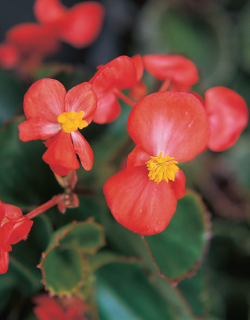
Ubiquitous but invaluable bedding plant, tolerating drought and shade, which produces fleshy stems and leaves and a constant run of small pink, white or red blooms on low, bushy plants. The ‘Alfa’ series have bronze-suffused foliage; the ‘Inferno’ series are remarkably vigorous; ‘Prelude’ series begin flowering very early.
Soil preference: Fertile, not too dry but free-draining
Aspect: Sun or part shade
Season of interest: Summer
Height and spread: Variable to 30cm × 20cm (12in × 8in)
Companion plants: Often used in large floral bedding schemes because of their uniformity, they are useful edgers for the patio or lawn and single colours work well in pots or to fill in spaces in box parterres.
Other good annuals
Omphalodes linifolia
Venus’ Navelwort Hardy annual
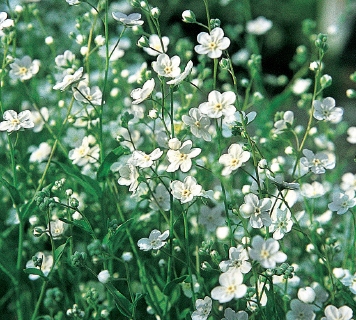
R. Coates
A rather fetching European member of the forget-me-not family with pale, grey-green, simple, narrow leaves and a long display of opalescent white flowers with navel-like centres. Though shortlived as an annual, this is a free-seeding species which, if happy, will form self-sustaining colonies.
Soil preference: Any free-draining, but not too dry
Aspect: Sun, part shade
Season of interest: Summer
Height and spread: 30cm × 20cm (1ft × 8in)
Companion plants: Best if allowed to spread in drifts among low-growing summer flowers such as violas and Mimulus, or to front low-growing shrubs. The foliage also harmonizes well with garden pinks, whereas the flowers make a pretty contrast in both colour and shape.
Orlaya grandiflora
Tender annual
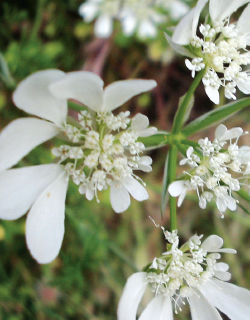
A Mediterranean member of the carrot family whose finely divided foliage is crowned, from late spring to midsummer, by a succession of shallow, dome shaped umbels. The outer, sterile flowers on each umbel carry large, creamy white asymmetrical petals, creating a beautiful lace-cap effect. Can be directly sown in warm regions, where it will also self-sow.
Soil preference: Any free-draining
Aspect: Sun
Season of interest: Summer
Height and spread: 30cm × 15cm (12in × 6in)
Companion plants: An exquisite, lacy companion to annuals with more solid-looking flowers, such as godetias, red poppies or Calendula. With deep blue larkspurs, the cream white lace caps make a cool contrast.



